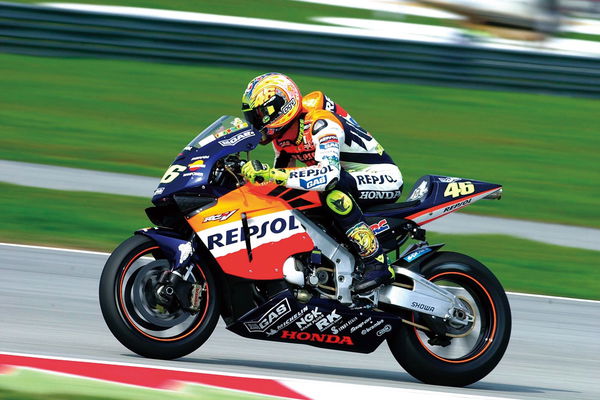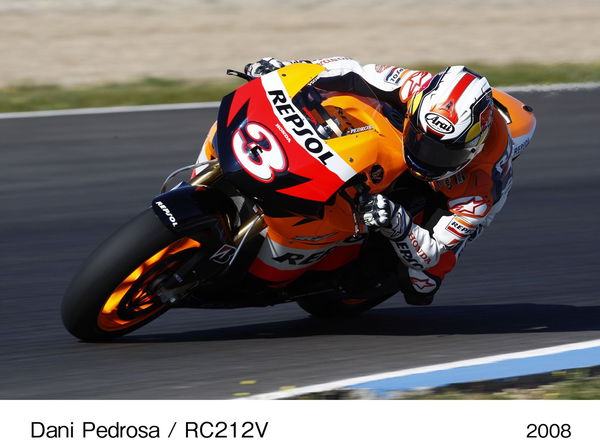Honda’s history of MotoGP magic
We take a look back at the most successful bikes in Honda’s modern-day MotoGP history

WITH more wins and championships than any other manufacturer in the four-stroke MotoGP era, Honda’s success in top-level motorcycle sport is impossible to dismiss.
During that time, the Honda RC211V, RC121V and RC213V have been a constant at the front of the lap-charts and the championship table. And that doesn’t happen by luck. Honda’s racing arm, HRC, has a knack of picking up the best riding talent and combining them with a motorcycle that will complement their riding style and ultimately make them a faster around a track.
In this feature, we take an in-depth look back at some of these bikes.

How does Honda race bike nomenclature work?
The link between the RC211V, RC212V and RC213V is easy to spot, but what is it that makes up this now easily recognisable naming convention?
If we take the RC211V, the RC part of the name denotes Racing Cycle, a denomination reserved for the firm’s race-only machines. The ‘21’ part of the name denotes the century – 21st in this case, and the second number ‘1’ means it is the first bike of that century. The RC212V was the second and the RC213V the third. The V simply denotes the engine is a V configuration, in this case a V-five.

Honda RC211V (2002-2006)
When MotoGP went four-stroke in 2002 Honda took the opportunity to the conventional race-bike-builders rule book out the window. Instead of the more tried and tested routes to MotoGP glory, they instead went their own way with a V-five engine when most of the grid had opted for V-four or inline engine configurations. The ‘big-bang’ configuration delivered the torque to the rear wheel in a more usable way was directly descended from the NSR500 two-stroke MotoGP machine the RC211V had superseded.
The result was a bike that was rider-friendly, while its compact design allowed the riders to get the maximum out of the RC211V. And talking of riders, there is a long list of greats who’ve swung their leg over the first four-stroke MotoGP machine of the modern era, including Valentino Rossi, Nicky Hayden, Dani Pedrosa, Max Biaggi and Sete Gibernau to name but a few. Between 2002 and 2006 the RC211V won three riders and four constructors titles.

Honda RC212V (2007-2011)
MotoGP’s technical regulations were rewritten for the 2007 season, reducing engine capacity from 990cc to 800cc. This forced Honda and HRC, and the rest of the MotoGP grid back to the drawing board.
The RC212V employed many of the lessons learned from the RC211V, but despite visual similarities to the previous bike, it was an all-new design. Now powered by a V4 engine that, thanks to its smaller capacity revved past 18,000rpm, 2,000rpm more than it’s larger capacity sibling.
The smaller engines produced less power and torque, so the bikes demanded a different riding style was needed and many assumed the bike would be slower than the 99cc era bikes.
Remarkably, the 800s immediately recorded faster lap times than the 990s at most tracks, their greater speed through the corners more than compensating for a slight reduction in acceleration and top speed. Even at super-fast Mugello – where Pedrosa’s RC212V hit 317.6kph/197.3mph – his fastest lap was only 0.037 seconds slower than the 990cc lap record.
Despite the gains lap-times, the bikes required complex electronics to manage the now peaky delivery of the narrow-angle V4 engine. The first improvement came from Honda’s F1 program in the form of a new torque sensor mounted on the gearbox output shaft. This device measured the torque to the rear tyre in real-time, helping the rider to apply just the right amount of throttle for a given scenario without overdoing it.
The next update, and probably one of modern MotoGP’s biggest to date, was the inclusion of the now-ubiquitous seamless shift transmission. While the idea of instant shifts, with no measurable delay, make it seem like acceleration would get the biggest benefit, it wasn’t. While acceleration was improved (marginally), it was upshifts and downshifts when cornering that gained the biggest boost. With bike remaining more composed and stable throughout the whole corner.

Honda RC213V (2012-present)
When the decision was taken to move to full 1000cc machines for the 2012 MotoGP World Championship Honda engineers designed their third brand-new MotoGP machine.
Honda decided to again change it up for the RC213V, starting with the engine. Building an all-new, wider-angle, 90-degree V4.
A 90-degree V4 isn’t as compact as a narrower-angle vee, but Honda decided the engine’s advantages would outweigh the disadvantages. A 90-degree V4 has perfect primary balance, which makes it smoother and more robust and therefore easier to tune, especially when engineers want to experiment with different big-bang firing configurations to modify power delivery.

When the 1000s first raced at Mugello in 2012, Dani Pedrosa and his RC213V lapped 4.9 seconds faster than the 2002 MotoGP record and reached 342.9kph/213.0mph on the main straight, 18.4kph/11.4mph faster than the first RC211V. These figures illustrate the progress made not only in straight-line performance but in overall performance, through improvements in all aspects of chassis design and electronics engineering.
In 2016 MotoGP underwent another major rule rewrite – Bridgestone tyres were replaced by Michelins and factory-made electronics were replaced by spec hardware and software, so the entire grid used the same electronic rider controls.
Aerodynamics also became a much bigger factor in MotoGP, with new aero designs increasing downforce at the front of the RC213V to further reduce wheelies.
Marquez proved to be the master of adapting to all these different technologies.

In 2019 the former 125cc and Moto2 World Champion once again scored 13 wins in a season, thanks partly to another major engine redesign that gave a significant horsepower boost. At Mugello 2019 the fastest RC213V belonged to LCR Castrol Honda rider Cal Crutchlow at 354.7kph/220.4mph, an improvement of 30.2kph/18.8mph over the first RC211V.
Marquez didn’t quite win the 2019 Italian GP – he took the flag 0.04 seconds behind local Danilo Petrucci – but it’s worth comparing their race time to MotoGP’s inaugural season. The 2019 Mugello race was two minutes and seven seconds faster than the 2002 event!












